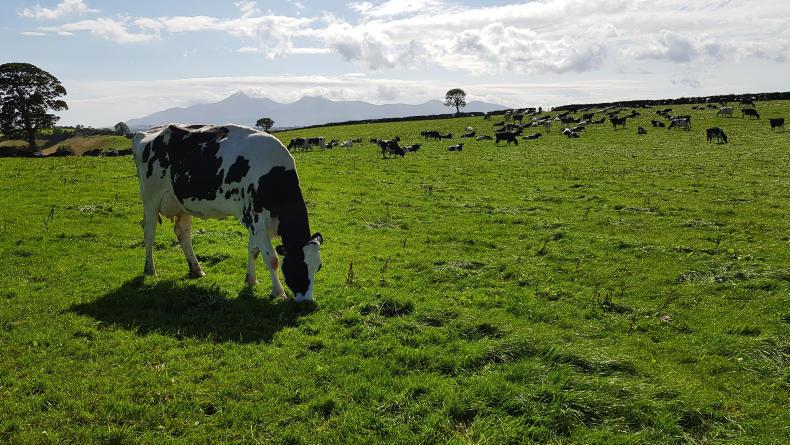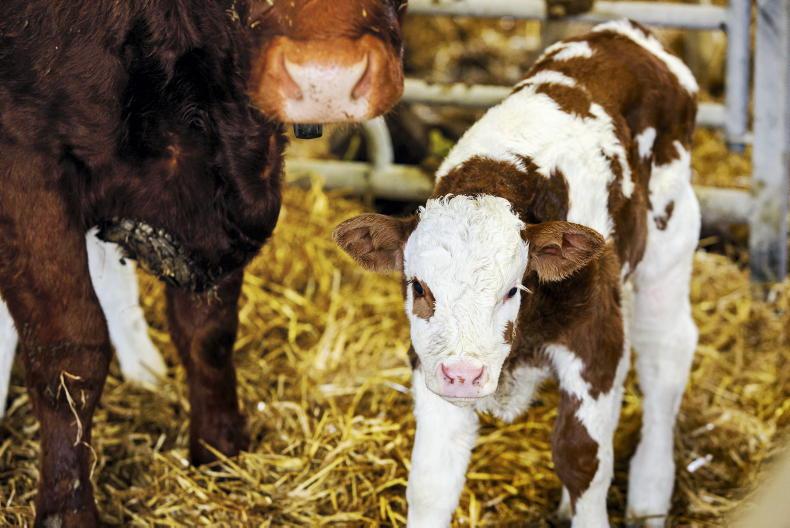A new set of participants are joining the Dairylink Ireland programme over the coming weeks as part of the second phase of the project.
Similar to the phase one participants, the new programme farms operate a range of dairying systems across different land types and climatic conditions.
Dairylink Ireland adviser Conail Keown will work with programme farmers over the next three years to achieve the overriding aim of the project: to optimise on-farm resources for profitable milk production.
The programme is not specifically about expansion or comparison of different dairying systems.
Instead, it aims to highlight the benefits of benchmarking and measuring to guide decision-making with farm management.
A change in breeding strategy takes several years to filter through into overall herd genetics and capital investment usually takes place on a phased basis as money becomes available
Weekly updates, based on programme farmer experience of the above, will continue to feature in the Irish Farmers Journal, with articles and additional video content also available online at www.ifj.ie/dairylink.
The six programme farmers from phase one of Dairylink have developed their farm businesses in a wide range of areas over the past three years.

A 10-acre field was sown out with a mixture of kales and swedes three weeks ago.
Addressing deficiencies in soil fertility, weekly grass measuring, developing grazing infrastructure, breeding for fertility and milk components, regular weighing of heifers and cashflow budgeting were identified by phase one participants as key steps taken on their farms.
However, making changes to a farm business takes time and money.
A change in breeding strategy takes several years to filter through into overall herd genetics and capital investment usually takes place on a phased basis as money becomes available.

Stephen Wallace farms near Clough in east Co Down.
For that reason, updates on the development of phase one farms will continue to feature, but on a less regular basis.
Weekly roundup
Calving is under way on autumn-calving herds.Spring-calving farms from phase one are scanning cows.Grass growth is holding up well and is above the seasonal average.Third-cut silage and some surplus grazing grass is being cut.Farmers continue to update and monitor fodder budgets.Farmer focus: Stephen Wallace, Clough, Co Down

We are milking 170 cows near the village of Clough in east Co Down. I farm with my wife Hazel and we have one full-time employee. Relief milkers are also used to allow time off from milking every other weekend.
Cows are predominantly Holstein Friesian, although there are some Fleckvieh genetics in the herd too. Average yield is 8,158 litres at 3.93% butterfat and 3.26% protein from 3t of concentrate per cow. Concentrates are fed via in-parlour feeders and through the mixer wagon in the winter.
The herd is mostly autumn-calving, although the calving profile spreads from mid-September through to April.
The farm extends to 270 acres, with one main block and another eight acres of an outlaying field. Cows are milked in a 14-a-side double-up parlour. There is auto ID in the parlour and an automatic drafting gate on the way out.
The farm is relatively dry and has stoney soils. The grazing season usually runs from mid-March to late October, although this can vary significantly between seasons.
A concrete lane runs through the milking platform and is the main route for cows walking to and from the parlour. One of the first measures we have taken as part of Dairylink is to open extra gaps into some paddocks. This will help reduce poaching at entry points in these paddocks, particularly in the autumn and spring.
Drought
Grass essentially stopped growing during the dry period in July and we had to buffer-feed cows with silage and increased concentrates. Leftover silage from last year was used for this, so we didn’t have to eat into 2018 silage stocks.
We have had plenty of rain in recent weeks and grass has come back well across the farm. We started weekly grass measuring on the milking platform this summer
However, the lack of rain meant second-cut silage was light and averaged around four bales per acre.
It is usually put in the pit, but we decided to cut and bale it in mid-July to capitalise on regrowth for a better third cut.
We have had plenty of rain in recent weeks and grass has come back well across the farm. We started weekly grass measuring on the milking platform this summer.
Growth last week stood at 78kg DM/ha and average farm cover is 1,240kg DM/ha (utilisable). Some grass on the milking platform has gotten ahead of cows and will be cut for silage.
There are around 130 acres of third-cut silage to make this week. Hopefully we should be well-enough stocked for fodder this winter.
We will do another fodder budget when third-cut silage is in to see exactly where we are.
There were 11 acres of wholecrop silage made from winter wheat this year and a 10-acre field was sown out with a mixture of kale and swedes three weeks ago.
The fodder crop was planted by minimum tillage with the grass burned off, disc harrowed and then drilled.
This is the first time in several years that we have planted a fodder crop. It will be grazed by heifers during the winter and will help take pressure off fodder stocks.
A new set of participants are joining the Dairylink Ireland programme over the coming weeks as part of the second phase of the project.
Similar to the phase one participants, the new programme farms operate a range of dairying systems across different land types and climatic conditions.
Dairylink Ireland adviser Conail Keown will work with programme farmers over the next three years to achieve the overriding aim of the project: to optimise on-farm resources for profitable milk production.
The programme is not specifically about expansion or comparison of different dairying systems.
Instead, it aims to highlight the benefits of benchmarking and measuring to guide decision-making with farm management.
A change in breeding strategy takes several years to filter through into overall herd genetics and capital investment usually takes place on a phased basis as money becomes available
Weekly updates, based on programme farmer experience of the above, will continue to feature in the Irish Farmers Journal, with articles and additional video content also available online at www.ifj.ie/dairylink.
The six programme farmers from phase one of Dairylink have developed their farm businesses in a wide range of areas over the past three years.

A 10-acre field was sown out with a mixture of kales and swedes three weeks ago.
Addressing deficiencies in soil fertility, weekly grass measuring, developing grazing infrastructure, breeding for fertility and milk components, regular weighing of heifers and cashflow budgeting were identified by phase one participants as key steps taken on their farms.
However, making changes to a farm business takes time and money.
A change in breeding strategy takes several years to filter through into overall herd genetics and capital investment usually takes place on a phased basis as money becomes available.

Stephen Wallace farms near Clough in east Co Down.
For that reason, updates on the development of phase one farms will continue to feature, but on a less regular basis.
Weekly roundup
Calving is under way on autumn-calving herds.Spring-calving farms from phase one are scanning cows.Grass growth is holding up well and is above the seasonal average.Third-cut silage and some surplus grazing grass is being cut.Farmers continue to update and monitor fodder budgets.Farmer focus: Stephen Wallace, Clough, Co Down

We are milking 170 cows near the village of Clough in east Co Down. I farm with my wife Hazel and we have one full-time employee. Relief milkers are also used to allow time off from milking every other weekend.
Cows are predominantly Holstein Friesian, although there are some Fleckvieh genetics in the herd too. Average yield is 8,158 litres at 3.93% butterfat and 3.26% protein from 3t of concentrate per cow. Concentrates are fed via in-parlour feeders and through the mixer wagon in the winter.
The herd is mostly autumn-calving, although the calving profile spreads from mid-September through to April.
The farm extends to 270 acres, with one main block and another eight acres of an outlaying field. Cows are milked in a 14-a-side double-up parlour. There is auto ID in the parlour and an automatic drafting gate on the way out.
The farm is relatively dry and has stoney soils. The grazing season usually runs from mid-March to late October, although this can vary significantly between seasons.
A concrete lane runs through the milking platform and is the main route for cows walking to and from the parlour. One of the first measures we have taken as part of Dairylink is to open extra gaps into some paddocks. This will help reduce poaching at entry points in these paddocks, particularly in the autumn and spring.
Drought
Grass essentially stopped growing during the dry period in July and we had to buffer-feed cows with silage and increased concentrates. Leftover silage from last year was used for this, so we didn’t have to eat into 2018 silage stocks.
We have had plenty of rain in recent weeks and grass has come back well across the farm. We started weekly grass measuring on the milking platform this summer
However, the lack of rain meant second-cut silage was light and averaged around four bales per acre.
It is usually put in the pit, but we decided to cut and bale it in mid-July to capitalise on regrowth for a better third cut.
We have had plenty of rain in recent weeks and grass has come back well across the farm. We started weekly grass measuring on the milking platform this summer.
Growth last week stood at 78kg DM/ha and average farm cover is 1,240kg DM/ha (utilisable). Some grass on the milking platform has gotten ahead of cows and will be cut for silage.
There are around 130 acres of third-cut silage to make this week. Hopefully we should be well-enough stocked for fodder this winter.
We will do another fodder budget when third-cut silage is in to see exactly where we are.
There were 11 acres of wholecrop silage made from winter wheat this year and a 10-acre field was sown out with a mixture of kale and swedes three weeks ago.
The fodder crop was planted by minimum tillage with the grass burned off, disc harrowed and then drilled.
This is the first time in several years that we have planted a fodder crop. It will be grazed by heifers during the winter and will help take pressure off fodder stocks.












SHARING OPTIONS